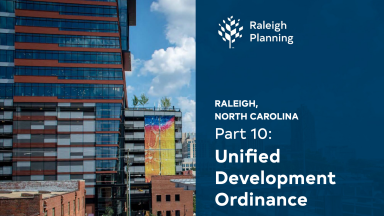For recently adopted text changes, please see the Adopted Text Changes webpage. For active and pending text changes, please see the Text Change Case page.
The Unified Development Ordinance, or UDO, contains most local regulations concerning the use and development of land and buildings, including zoning, subdivision, stormwater, and natural resource conservation. The UDO was adopted in 2013 as text change TC-3-13, and became fully effective throughout Raleigh’s city limits and planning jurisdiction in 2016 with the adoption of the UDO Remapping, which applied new UDO districts to approximately one-third of the land area zoned by Raleigh (rezonings Z-27-14 and Z-27D-14).
The purpose and intent of the UDO is to preserve, protect and promote the public health, safety and general welfare of residents and businesses in the City. More specifically, the UDO seeks to achieve the following objectives:
A. Implement the policies and goals contained within officially adopted plans, including the Comprehensive Plan;
B. Improve the built environment and human habitat;
C. Conserve and protect the City’s natural beauty and setting, including trees, scenic vistas, and cultural and historic resources;
D. Ensure that new development conserves energy, land and natural resources;
E. Protect water quality within watershed critical areas, the general watershed areas of designated water supply watersheds and other watershed districts;
F. Encourage environmentally responsible development practices;
G. Promote development patterns that support safe, effective and multi-modal transportation options, including auto, pedestrian, bicycle and transit and therefore minimize vehicle traffic by providing for a mixture of land uses, walkability and compact community form;
H. Provide neighborhoods with a variety of housing types to serve the needs of a diverse population;
I. Promote the greater health benefits of a pedestrian-oriented environment;
J. Reinforce the character and quality of neighborhoods;
K. Remove barriers and provide incentives for walkable projects;
L. Protect and promote appropriately located commercial and industrial activities in order to preserve and strengthen the City’s economic base;
M. Encourage compact development;
N. Ensure that adequate facilities are constructed to serve new development;
O. Provide for orderly growth and development of suitable neighborhoods with adequate transportation networks, drainage and utilities, and appropriate building sites;
P. Save unnecessary expenditures of funds by requiring the proper initial construction of transportation networks, sidewalks, drainage facilities, and utilities; and
Q. Provide land records for the convenience of the public and for better identification and permanent location of real estate boundaries.
